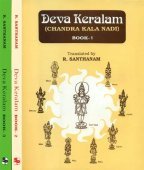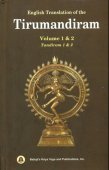Kecari, Kēcari, Kēcāri: 2 definitions
Introduction:
Kecari means something in biology, Tamil. If you want to know the exact meaning, history, etymology or English translation of this term then check out the descriptions on this page. Add your comment or reference to a book if you want to contribute to this summary article.
Biology (plants and animals)
Source: Google Books: CRC World Dictionary (Regional names)1) Kecari in India is the name of a plant defined with Crocus sativus in various botanical sources. This page contains potential references in Ayurveda, modern medicine, and other folk traditions or local practices It has the synonym Safran officinarum Medik. (among others).
2) Kecari is also identified with Oxalis corniculata It has the synonym Acetosella villosa Kuntze (etc.).
Example references for further research on medicinal uses or toxicity (see latin names for full list):
· Nova Genera et Species Plantarum (1821)
· Repertorium Specierum Novarum Regni Vegetabilis (1927)
· Flora of the Southeastern United States
· Phytologia (1979)
· Bulletin de la Société Impériale des Naturalistes de Moscou (1838)
· Fl. Ital. (1860)
If you are looking for specific details regarding Kecari, for example extract dosage, chemical composition, side effects, health benefits, diet and recipes, pregnancy safety, have a look at these references.

This sections includes definitions from the five kingdoms of living things: Animals, Plants, Fungi, Protists and Monera. It will include both the official binomial nomenclature (scientific names usually in Latin) as well as regional spellings and variants.
Languages of India and abroad
Tamil dictionary
Source: DDSA: University of Madras: Tamil LexiconKēcari (கேசரி) noun < kēsarin.
1. Lion; சிங்கம். கேசரி மாய [singam. kesari maya] (தணிகைப்புராணம் சீபர. [thanigaippuranam sipara.] 574).
2. See கேசரியாசனம். (பிங்கலகண்டு) [kesariyasanam. (pingalagandu)]
3. Citron. See கொம்மட்டிமாதுளை. ((சங்கத்தகராதி) தமிழ்சொல்லகராதி) [kommattimathulai. ((sangathagarathi) thamizhsollagarathi)]
4. Wheat flour boiled with saffron and sugar; குங்குமப்பூவுஞ் சர்க்கரையுங் கலந்து பக்குவஞ் செய்யப்பட்ட கோதுமை ரவைப் பண்டம். [kungumappuvugn sarkkaraiyung kalanthu pakkuvagn seyyappatta kothumai ravaip pandam.]
--- OR ---
Kēcāri (கேசாரி) noun < kēsara. Horse's mane; குதிரைக்கழுத்தின் மயிர். பலவாகிய கேசாரியை யுடைய குதிரைகள் [kuthiraikkazhuthin mayir. palavagiya kesariyai yudaiya kuthiraigal] (பத்துப்பாட்டு: நெடு [pathuppattu: nedu] 93, உரை [urai]).
Tamil is an ancient language of India from the Dravidian family spoken by roughly 250 million people mainly in southern India and Sri Lanka.
See also (Relevant definitions)
Starts with: Kecari-p-paruppu, Kecarikacceti, Kecarikam, Kecarippu, Kecariyacanam, Kecariyarakkirai.
Ends with: Aracakecari, Attumakecari, Iracakecari, Narakecari, Nirukecari, Parakecari, Pattaikecari, Pattakecari, Vijayakecari.
Full-text (+24): Keshari, Kesarisuta, Kesarin, Kaesari thogari, Kaesari baele, Kecari-p-paruppu, Kumkuma kaesari, Purusha kaesari, Kaesari, Kesari rangu, Kesari chettu, Kesarimavu, Lal kesari, Vijayakecari, Pattaikecari, Raja-kecarivatakam, Kirti, Iracakecari, Narakecari, Shritala.
Relevant text
Search found 17 books and stories containing Kecari, Kēcari, Kēcāri, Kesari, Kaesari, Kechari, Kesaari, Kaesaari; (plurals include: Kecaris, Kēcaris, Kēcāris, Kesaris, Kaesaris, Kecharis, Kesaaris, Kaesaaris). You can also click to the full overview containing English textual excerpts. Below are direct links for the most relevant articles:
Animal Kingdom (Tiryak) in Epics (by Saranya P.S)
Chapter 3.9 - The story of Kesari (Monkey characters, part 3)
Chapter 3.14 - The story of Anjana (Women characters, part 1)
Chapter 3.5 - The story of Hanuman (Immortal characters, part 2)
Vastu-shastra (5): Temple Architecture (by D. N. Shukla)
Temples of Orissa (1): Bhuvaneśvara < [Chapter 12 - History of Hindu Temples (Prāsādas and Vimānas)]
Śikharottama Prāsādas (Nāgara Temples)—The evolution of Śikhara < [Chapter 12 - History of Hindu Temples (Prāsādas and Vimānas)]
The Temples of Orissa < [October 1955]
The Temples of Orissa < [October 1955]
Is this the Democracy that India Deserves? < [October – December, 2005]
Early Chola Temples (by S. R. Balasubrahmanyam)
Temples in Siddhalingamadam < [Chapter II - Temples of Parantaka I’s Time]
Parantaka I < [Chapter XIV - Conclusion]
Temples in Andanallur (14th year) < [Chapter X - Historical Survey]
Significance of the Moon in Ancient Civilizations (by Radhakrishnan. P)
6. Pratyusha Banerjee Sucide Case < [Chapter 14 - Case Studies of Natal Chart]
7. Horoscope Analysis on Hyper-tension and Cardiac Problem < [Chapter 14 - Case Studies of Natal Chart]
17. Chandra-yogas in Astrology < [Chapter 5 - Adoration of the Sun and Moon]
Bhagavad-gita-rahasya (or Karma-yoga Shastra) (by Bhalchandra Sitaram Sukthankar)
Related products



